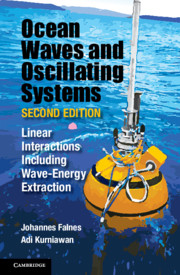Book contents
- Frontmatter
- Contents
- Prefaces
- Chapter One Introduction
- Chapter Two Mathematical Description of Oscillations
- Chapter Three Interaction between Oscillations and Waves
- Chapter Four Gravity Waves on Water
- Chapter Five Wave–Body Interactions
- Chapter Six Oscillating-Body Wave-Energy Converters
- Chapter Seven Oscillating Water Columns and Other Types of Wave-Energy Converters
- Chapter Eight Wave-Energy Converter Arrays
- Bibliography
- Index
Chapter Six - Oscillating-Body Wave-Energy Converters
Published online by Cambridge University Press: 12 May 2020
- Frontmatter
- Contents
- Prefaces
- Chapter One Introduction
- Chapter Two Mathematical Description of Oscillations
- Chapter Three Interaction between Oscillations and Waves
- Chapter Four Gravity Waves on Water
- Chapter Five Wave–Body Interactions
- Chapter Six Oscillating-Body Wave-Energy Converters
- Chapter Seven Oscillating Water Columns and Other Types of Wave-Energy Converters
- Chapter Eight Wave-Energy Converter Arrays
- Bibliography
- Index
Summary
Referring to a simple illustration, a verbal explanation is given by the essential, but perhaps paradoxical, statement that to absorb wave energy from a wave by means of an oscillating system, it is required that the system radiates a wave which interferes destructively with the incident wave. Then various mathematical relations are derived concerning the conditions for an oscillating body to remove energy from an incident wave. The mathematical conditions for wave-power absorption may be illustrated as a paraboloid-shaped 'island' on an infinite complex-plane 'ocean' surface. The top of this 'island' corresponds to maximum absorbed power. An additional matter is the optimum control of a wave-energy converter (WEC) body. Thus far, the WEC body's shape and oscillation mode have been taken into account, but not its physical size. The latter is an important parameter related to the cost of the WEC, when the Budal upper bound is explained and discussed. Another important phenomenon, related to the Keulegan–Carpenter number, is discussed, in relation to an example of a WEC body. In a final section of the chapter, a WEC body, oscillating in several modes of motion, is discussed.
Keywords
- Type
- Chapter
- Information
- Ocean Waves and Oscillating SystemsLinear Interactions Including Wave-Energy Extraction, pp. 204 - 241Publisher: Cambridge University PressPrint publication year: 2020

